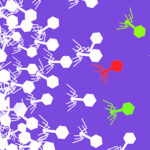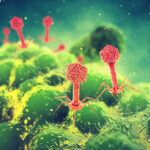A team led by Environmental Genomics and Systems Biology (EGSB) staff scientist Vivek Mutalik demonstrated for the first time that they can, on a genome-wide scale, identify phage genes that are essential (or not) to infecting bacteria, and then replace non-essential DNA with distinctive barcode tags. These barcodes could enable investigators and clinicians to quickly identify and track different phages in diverse settings, similar to how product barcodes are used in supermarkets. Brought to scale, the method stands to unlock potent biotechnology applications relevant to agriculture, the environment, human health, and more.
Biosciences Researchers Launching Biopreparedness Projects
Two scientists in the Area, Greg Hura and Vivek Mutalik, are heading up research projects that are part of the Department of Energy’s Biopreparedness Research Virtual Environment (BRaVE) initiative. Yasuo Yoshikuni, a scientist at the Joint Genome Institute, is part of a third project that is being led by Brookhaven National Laboratory. These projects will leverage bioimaging expertise to develop better therapies and vaccines for viruses, develop a high-throughput platform to rapidly design countermeasures to drug-resistant pathogens, and unlock the molecular basis of plant-pathogen interactions to create resilient bioenergy crops.
Dub-seq Used to Screen Phage Proteins for Antibiotic Properties
As conventional antibiotics continue to lose effectiveness against evolving pathogens, scientists are keen to employ the bacteria-killing techniques perfected by bacteriophages (phages), the viruses that infect bacteria. One major challenge is the difficulty of studying individual phage proteins and determining precisely how the virus wields these tools to kill their host bacteria. A team of researchers from Berkeley Lab, UC Berkeley, and Texas A&M University worked together on a high-throughput genetic screen to identify which part of the bacteria the phages were targeting.
Biosciences Area FY23 LDRD Projects
The projects of 22 Biosciences Area scientists and engineers received funding through the FY23 Laboratory Directed Research and Development (LDRD) program.
How to Edit the Genes of Nature’s Master Manipulators
A team led by CRISPR pioneer Jennifer Doudna and her longtime collaborator Jill Banfield has developed a clever tool to edit the genomes of bacteria-infecting viruses called bacteriophages using a rare form of CRISPR. The ability to easily engineer custom-designed phages—which has long eluded the research community—could help researchers control microbiomes without antibiotics or harsh chemicals, and treat dangerous drug-resistant infections. A paper describing the work was recently published in Nature Microbiology.
Was this page useful?








